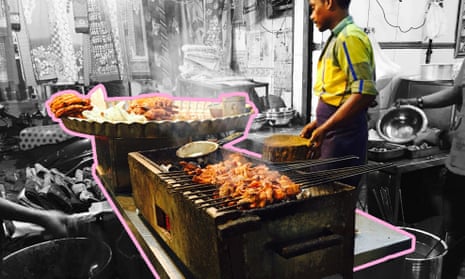Barbecue talk is usually delivered in an American accent. The land of pit ribs and tattooed barbecue bros has come to dominate how we perceive grilling outdoors. Yet people cook over charcoal and flames all around the world. Looking for fresh barbecue inspiration this summer? It is time to broaden your horizons.
The Philippines
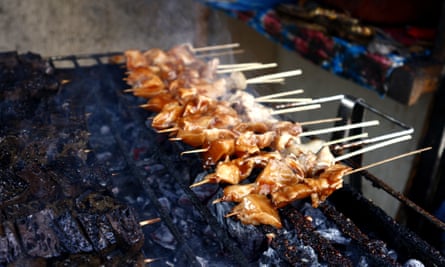
Cooking outdoors is standard in the Philippines. “You’re probably considered middle-class if you have an inside kitchen,” says Rachel Stockley, a chef of Filipino heritage who cooks at Baratxuri in Manchester.
“Like Thai food, Filipino is all about hot, sour, sweet, salty flavours,” says Stockley, with sawsawan dipping sauces essential in that. Commercial versions can include a variety of ingredients, even strawberries, but the basic recipe is equal parts white sugar cane vinegar or rice wine vinegar and light soy mixed with finely diced white onion, garlic, chilli, lime juice and fish sauce – “Filipino patis if you can get it.”
“That condiment or salsa is used with everything from barbecued pork belly to grilled tilapia,” says Stockley, but building in those four dimensions of flavour can begin much earlier, too. Before it is grilled, explains Mary San Pablo, the owner of London supper club and delivery kitchen Luto, pork or chicken is “half-brined, half-marinated” in an approximate mix of equal parts lemonade (usually 7Up or Sprite), soy sauce and sugar cane vinegar (watered-down cider vinegar, alternatively), with added garlic and pepper and sometimes extra sugar and banana ketchup. Lemongrass is also beaten into the marinade and then used as a brush to baste the meat as it caramelises on the grill.
San Pablo recommends marinating skewers of interspersed fatty pork belly and shoulder overnight: “You want a deep flavour penetration.” Serve your pork or chicken with grilled corn or barbecued aubergines, scooping out the flesh and topping it with tomatoes, chopped shallots and toyomansi, a mix of soy and juice from the Philippines’ beloved calamansi citrus fruit. You can substitute lemon and lime for calamansi, but, if you are really keen, Ikea sells small calamansi, AKA calamondin, trees and San Pablo has harvested “quite a lot of juice” from these.
The Caribbean
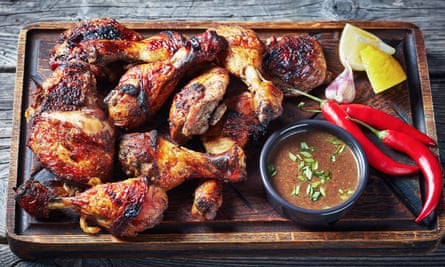
“From an early age going to St Vincent, I vividly remember the Friday night ‘jump-off’ – barbecues where there’d be various meats in West Indian spices, jerk chicken being the classic,” says James Cochran, chef-owner at London’s Around the Cluck.
Used on ingredients from goat to red snapper, jerk is both a dry rub and a glazing liquid used during cooking. Perfecting your rub could take years. Cochran’s contains 15 finely balanced ingredients ranging from garlic and onion powder to nutmeg, smoked paprika and essential Jamaican allspice or pimento. Unusually, however, he does not use it as a dry rub. He prefers to brine chicken thighs in a 10% salt solution with plenty of the jerk seasoning for four hours. To get a nice balance of heat and smoke, he only uses Scotch bonnet chillies in his glaze – which he makes from rum, guava jam or honey and jerk spices.
Sides of fried plantain, spinach-like callaloo and rice and peas can be cooked ahead and served cold so you can concentrate on barbecuing. But, says Shaun McAnuff, half of Jamaican food exponents Original Flava, jerk-seasoned vegetables and even fruits are increasingly common at Jamaican barbecues, partly inspired by the vegetarian Ital diet followed by many Rastafarians. McAnuff also suggests abandoning burger buns for festival, a sub-shaped, slightly sweet fried cornmeal roll: “They’re predominantly eaten with fish but they’re great for carnival street food and barbecues, hence the name.”
To drink, Cochran demands rum punch: “Rum, grenadine and nutmeg with orange, pineapple or guava juice, shaken with loads of ice. Lethal!”
India and Pakistan
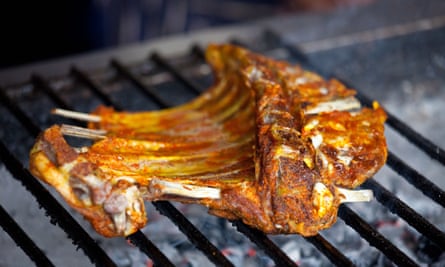
“There is no such thing as Indian food,” says the food writer and chef Romy Gill. “It’s very regional. We all speak different languages, look different, eat different.”
That variety offers plenty of barbecue inspiration for dishes such as Gill’s Punjabi-style chicken wings marinated in ginger, garlic, fresh turmeric, honey, green chillies and lime juice, or her Keralan-style beef or jackfruit ribs flavoured with tamarind chutney, tandoori masala spices, ginger and garlic. “Cook them on a quick high burst of heat,” advises the Ready Steady Cook regular, “and then gently so the outside is charcoaled dark and the inside beautifully pink.”
Alternatively, you could start with simple skewers of cubed meats marinated in a paste of ginger, garlic, green chillies and garam masala. Tip: use grated raw green papaya to tenderise tougher meats such as goat or mutton. Later, move on to perfecting your minced seekh kebabs. Use seasoned lamb that is about 20% fat. “Without fat it’s not really tasty,” says Gill. Thread a tennis-sized ball of mince on to the bottom of a skewer, then tease and stretch into shape with wet fingers, no oil: “The moment you use oil it’s going to fall down.” If you want to wrap your kebab in a naan with salad and chutneys, you can bake naans on the BBQ by cooking them on foil or on a baking tray over the coals.
Across the wider Indian subcontinent, the opportunity to drill down into specific authentic flavours is endless, says Sumayya Usmani, Pakistani food expert and the owner of Glasgow’s Kaleyard Cook School and Kitchen. For instance, Afghani-influenced kebabs of skewered lamb use just a light lemon and salt marinade: “The rest of the flavour comes from smaller alternating pieces of lamb fat or dark meat.” Conversely, Karachi’s chicken tikka packs in the spice. Chickens are quartered on the bone and marinated, not in yoghurt, but in lemon juice with ground Kashmiri chillies, ginger, garlic, green chilli paste, salt, ground cumin, garam masala and turmeric: “It’s extremely red and slit so the flavours go right to the bone.”
Russia
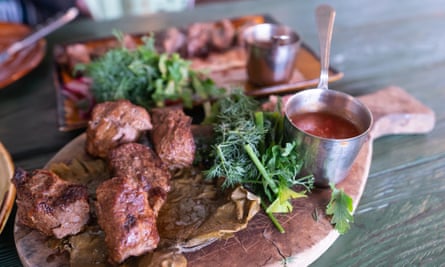
On fine days, even in winter, Alissa Timoshkina’s family would regularly head out into the Siberian woodlands outside Omsk to cook over fire. “It is,” says the author of Salt & Time, “a big part of my culinary culture.”
Rugged shashlik kebabs of beer-marinated pork or Georgian-style beef, the chunks of meat divided by pieces of onion, were the centrepiece of such meals. The beef is marinated in red wine, tomatoes and onions and, before grilling, is rubbed with the Georgian herb mix khmeli suneli. Specialist suppliers such as Seasoned Pioneers sell it pre-mixed or you could attempt your own. It is complex but apart from a couple of ingredients available from herb nerds such as Steenbergs (summer savory, marigold), uses readily available dried herbs, including (depending which recipe you work from) marjoram, dill, mint, parsley, coriander, fenugreek leaves and seeds, black pepper and bay leaves.
The meat would be swiped from the skewer using Armenian lavash flatbreads and perhaps dressed with homemade Georgian chilli sauce known as adjika, thickened with concentrated tomato puree: “In the Soviet days, there were no ready bought sauces.” In summer, shashlik might be bundled together with pickles and salads of seasonal vegetables dressed with unrefined sunflower oil and dominated by “crazy amounts of chopped parsley, dill and coriander, so herbs are the bulk of the salad”. Note: if you cannot find lavash in local Turkish or Kurdish shops, tortillas or chapattis will work as a stand-in.
Finally, the family would cook jacket potatoes as the fire subsided, throwing them in without foil and, later, topping them with “really fatty, super-rich sour cream, dill and chopped garlic”, scooping the insides from ashy jackets with a spoon: “We’d have it as a side but it’s a meal in itself.”
Peru
You might balk at digging up the back garden for pachamanca, Peru’s famous submerged fire-pit feast. But anticuchos, marinated skewers similar to the Japanese yakitori, is a Peruvian obsession we can all get into.
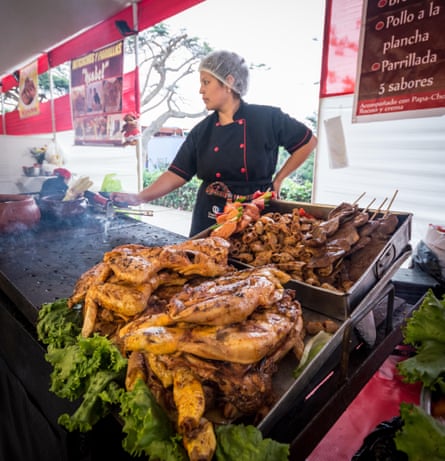
“There’s huge tradition behind it,” says the chef at Birmingham’s Chakana, Robert Ortiz, a man who discovered his talent for cooking during a school barbecue contest. “Anticuchos was done at weekends on street corners and families would gather to eat. Now anticucheria restaurants just do the skewers.”
Traditionally made with deliciously beefy ox heart and other bits of offal, anticuchos now incorporate everything from chicken to octopus and chorizo. The marinade is always the same, however, based around aji panca, a smoky, fruity chilli you can find dried or in paste form online. The skewers are marinated overnight in (this would cover 40 to 50, for a party), 1kg of pureed rehydrated chillies, let down with water; 200g garlic puree; four bay leaves; 100ml white wine vinegar; 60g sugar; 40g salt; 20g each of cumin and ground black pepper.
Serve the anticuchos with boiled and barbecued corn cobs and waxy potatoes (eg Charlotte, Jersey Royals). Dress them with a simple salsa of onion, coriander, fresh chilli and lime juice or aji verde, a smoothly blended sauce of yellow aji amarillo paste, lots of coriander, garlic, onion and a few blobs of mayonnaise. Wash all that down with a pisco sour.
